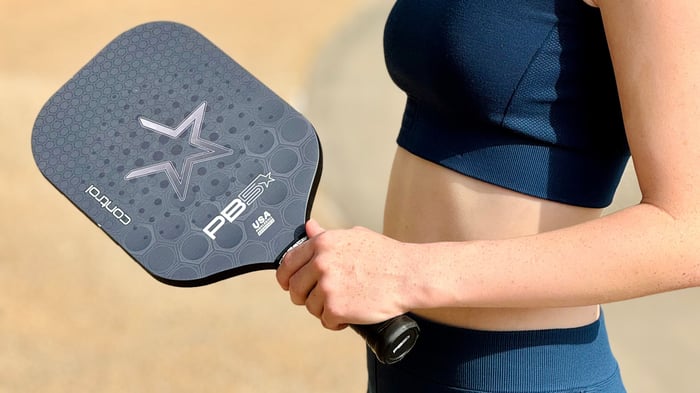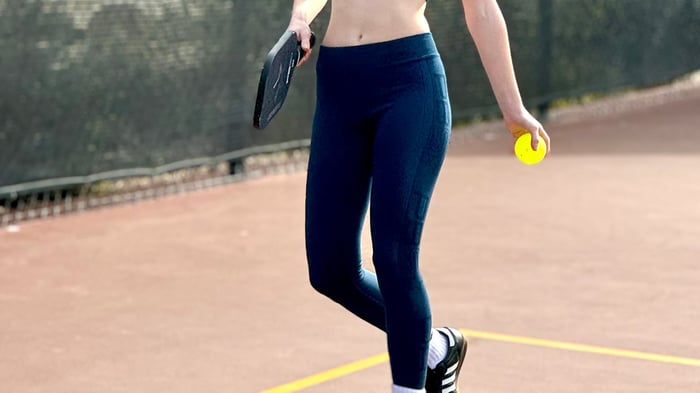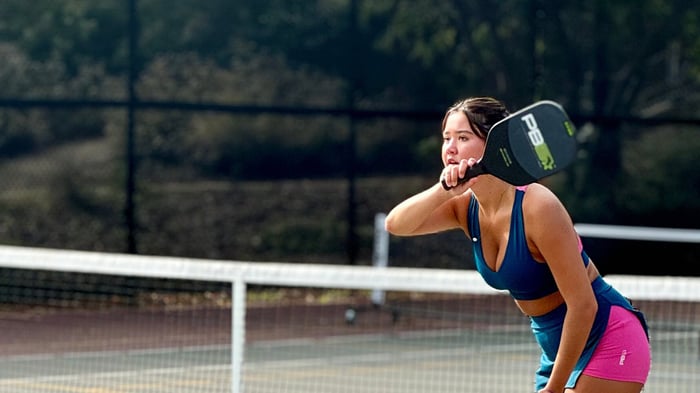Key takeaways:
Strong practice starts with specific goals that fit your game—not generic plans or random drills.
A good mix of solo work, partner drills, and performance tracking keeps your sessions balanced.
Consistency and structure are more effective than complicated routines.
Once you've played pickleball for a bit, practice starts to shift. It's less about getting reps and more about doing the work that moves your game forward. It's easy to stay busy on the court, but it helps to know what you're working on and why. Keep it simple—just focus on what needs work and choose a plan that fits how you play.
This guide breaks down how to set pickleball goals that make sense, structure your practice around them, and stay motivated when things hit a plateau. You might be practicing solo, drilling with a partner, or working on one small piece of your game—but wherever you're starting from, you'll find something here to help you keep moving. And if you need quality pickleball gear to support that work, PB5star's got you covered.
Set goals that work
Good goals give your pickleball practice direction. Without them, it's easy to get stuck in routines that don't actually move your game forward. Instead of fixing everything at once, narrowing your focus makes things manageable and more effective.
Here's how to set goals that help you improve:
Pick one skill to sharpen: Choose a shot or movement you want to master, like a reliable third-shot drop or smoother split steps. Instead of trying to "get better at everything," zeroing in on one focus builds faster results.
Track small wins: Write down practice times, shot success rates, or quick notes after games. These small checkpoints remind you how much you're improving, even when it feels slow.
Break goals into steps: Big goals can feel overwhelming if you don't chop them into smaller pieces. For example, "improve net play" could start with "practice 10 minutes of kitchen volleys thrice a week."
Stay true to your playing style: Focus on skills that build on your natural strengths. If quick reflexes are already your edge, refining your volley game might be a smart next move.
Set timelines that fit your pace: Give yourself enough time to build skills without losing urgency. Instead of "I'll fix my backhand sometime," aim for "I'll improve my backhand consistency by the end of the month."
Mix "performance goals" (like "land 8 out of 10 serves") with "mental goals" (like "reset quickly after mistakes") to build a well-rounded game that's strong both technically and mentally.
Practice with purpose
Time on the pickleball court matters—but what you do with that time makes the real difference. If your drills don't align with what you're trying to improve, you can repeat the same mistakes without noticing.
Small changes in how you approach a drill can make a noticeable difference. Add targets, shift pacing, or swap in drills that reflect how you play. That structure helps you improve faster and keeps your sessions more focused and satisfying.
Solo practice ideas:
Practicing on your own gives you the space to slow down, stay focused, and work through details without distractions. It's a great way to clean up pickleball technique and build consistency.
Swing motion practice: Stand in front of a mirror or record a short video. Focus on smooth, balanced strokes that feel repeatable. Watching your form in real-time helps correct habits before they become ingrained. Use the Core Performance Tee to stay cool and comfortable while you drill, especially during longer sessions.
Footwork drills: Quick side-steps and split-steps (small hops to reset your stance) improve your balance and movement efficiency. Practicing without a pickleball lets you isolate your focus. For extra support during movement-heavy drills, try the PB5 Court2 Shoes—they're built for stability and comfort across quick lateral steps.
Wall drills: Hit controlled forehands and backhands against a wall to improve timing and consistency. Add targets or aim zones with tape to work on precision.
Serve targets: Set up cones or chalk marks in specific corners of a service box and work on landing consistent serves with spin or depth. The PB5star Balance Paddle offers great control for precision work, helping you dial in consistent spin and placement.
Partner practice ideas:
Working with a partner adds pressure, rhythm, and real-time feedback—three things solo drills can't fully replicate. These ideas help build teamwork and shot control while keeping things fun and challenging.
The 7-11 challenge: One player holds the kitchen line while the other controls the baseline. Each player works toward a point goal with consistent, controlled shots. This pickleball training exercises focus, touch, and the ability to adjust under pressure.
Volley speed drills: Start slowly, then build speed as your confidence grows. Focus on staying low, reacting quickly, and using soft hands for control.
Third-shot drop rallies: Alternate between serving and executing third-shot drops while your partner applies light pressure. This builds patience, timing, and shot selection.
Cross-court dink battles: Hit dinks diagonally across the kitchen to focus on soft control and movement. This sharpens your footwork and improves finesse under pressure.
Reset when things stall
Even when you've got a good rhythm, things can stall out. If your pickleball sessions start feeling flat or your progress slows, it might be time to shake things up—not overhaul everything, just tweak a few things to regain momentum.
Start by looking at what's been on repeat:
Are you doing the same drills the same way every week?
Is your focus too broad—or maybe too narrow?
Have your goals shifted, but your training hasn't caught up?
Then try adjusting just one thing:
Swap out a drill for something fresh that targets the same skill.
Add a little movement or tempo to keep your brain engaged.
Change up how often or how long you practice.
Try switching between solo and partner drills to mix up the feel.
A small shift can go a long way when your routine gets stale. Try one change, give it a little space, and see what clicks.
Keep your game moving
If you want to improve at pickleball, the most useful thing you can do is show up with a plan. You don’t have to overthink every detail— focus on something specific and build around it. A few reps with a clear purpose will always beat mindless hitting.
Give your practice a structure that fits your pace, style, and goals. Tweak things when they stop working, and don't stress if progress takes a little time—it usually does. And when you're ready to level up your gear, PB5star has what you need to make those pickleball sessions count.
FAQs
How often should I practice to see improvement?
Two to three times a week is a solid target, but that doesn't mean hours each day. A few focused sessions are more useful than scattered ones. Depending on your schedule, mix short solo drills with longer group games.
Should I always practice with a partner?
Nope. Some things are better practiced solo—like footwork, consistency, or serve placement. Partner work is great for pressure and timing. A good mix of both keeps things balanced.
What's a good way to warm up before practicing?
Keep it light. Jog a few laps, shuffle side to side, and do some slow swings. Hit a few easy dinks to get your eyes and hands on the same page.
How do I know which skill to work on first?
Start with what's frustrating you most in pickleball games. Missing returns? Struggling with drops? That's your starting point. Work on one area at a time so you notice the improvement.
Do I need fancy equipment to train well?
No. A paddle, some balls, and enough space to move are more than enough. Gear helps, but it's not what makes practice effective.
Is it okay to just play games for practice?
Games are great, but they don't cover everything. You don't get many reps of the same shot in a match. That's why drills matter. Use games to test what you've been working on—and to keep things fun.







